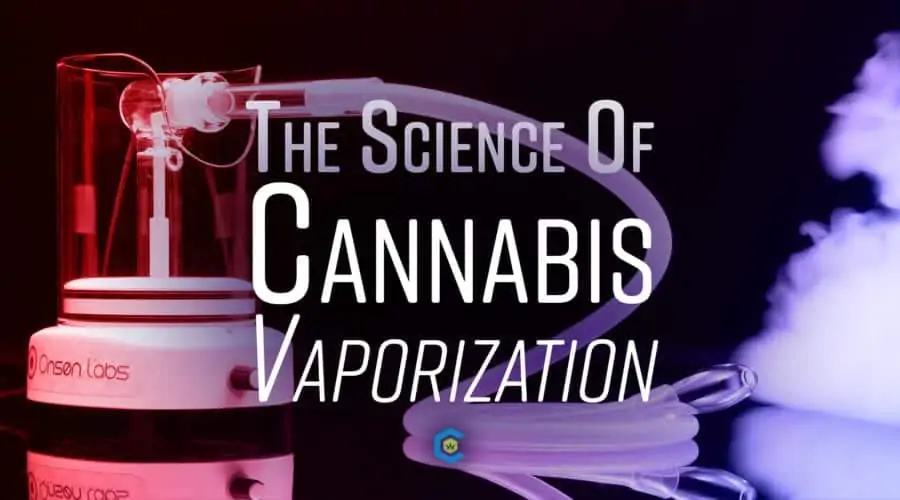The Unparalleled Science of Cannabis Vaporization
The following content has been produced in partnership with Onsen Labs and features cannabis vaporization expert, Mr. Steven Gough, President of Onsen Labs & Gough Industries.
Since its discovery, the cannabis plant has been cultivated and extracted to create a diverse variety of products that extend far beyond its flowering buds. The process of cannabis vaporization involves heating flower or cannabis concentrates to a temperature just below it’s point of combustion at 392°F 1. While this technique of consuming cannabis is hardly new, the scientific community is still catching up to speed on the benefits and possible adverse events of cannabis vaporization. The following article will investigate the science of cannabis vaporization and explore aspects such as the perfect temperature for vaporization, the benefits of vaporization relative to smoking cannabis and the general scientific mechanism behind cannabis vaporization.

An Expert Opinion on Cannabis Vaporization: Steven Gough from Onsen Labs
“Man invented fire a very long time ago and traditions should only change when a better method comes along. Now that humanity has figured out ‘fire’, we understand thermodynamics. As a result, this has led to a new, low-heat method of cannabis consumption called vaporization that has many benefits” ~ Steven Gough, President Onsen Labs. Joining us on this educational journey into the science of cannabis vaporization is subject matter expert, Steven Gough, president of Onsen Labs and Gough Industries, Inc. Steven helps us dig deeper into what happens on a molecular level when we vaporize cannabis and how it is an evolution from smoking and other routes of administration. Huge shout out to Steven, Onsen Labs and all the professionals in the cannabis community that promote healthy cannabis education and debate!
What Is Cannabis Vaporization?
The term vaporization refers to the conversion of a substance from the solid or liquid phase to a gaseous one. In the context of cannabis, this means heating either cannabis concentrate, extract or flower to the point just before it’s combustion at 392°F (~200°C) 1. To learn more about the various types of cannabis concentrates, check out The Diverse World of Dabs: A Closer Look at Cannabis Concentrates! Vaporization is quickly becoming a popular method of consumption due to the various advantages it has over smoking, such as the ability to use higher potency cannabis and eliminate many of the toxins commonly found in cannabis smoke 2. Steven also presents the argument that an even better and more complete cannabinoid and terpenoid profile can be obtained from vaporization versus smoking. Thus, vaporized cannabis could help elicit a greater therapeutic response by more effectively exploiting the intermolecular harmony of Cannabis Sativa, dubbed the “entourage effect”, while also reducing harm from smoking!

Vaporizing Cannabis Reduces Exposure to Hazardous Combustion Byproducts
One of the primary benefits of cannabis vaporization is due to the significantly decreased risk to respiratory health as one is exposed to far less toxins when compared to smoking. Indeed, the potential risks and epidemiological implications of long-term cannabis smoking are still being studied and debated (to read more about this, check out our blog: Is Smoking Cannabis Dangerous?). However, it has been clearly established that following combustion of the cannabis plant, dangerous byproducts such as “tar, polycyclic aromatic hydrocarbons (PAH), carbon monoxide, and other carcinogens (e.g. benzene)” are present in the smoke 2–5. This is in contrast to high-quality cannabis vaporizers, which virtually eliminate these toxic byproducts almost entirely 3. When comparing cannabinoid versus non-cannabinoid constituents of cannabis smoke versus that of cannabis vapor, only 3 non-cannabinoids were found in the vapor, while about 150 chemicals were identified in the smoke of combusted cannabis, including 5 PAHs, known as strong carcinogens 4. However, this raises an important caveat when discussing implications of vaporizing cannabis on respiratory health: when it comes to cannabis vaporizers, quality matters!

Cannabis Vaporizers: Why High-Quality Material Matters!
When it comes to the wide world of cannabis vaporizers, it is important to remember that not all instruments and devices are created equal. While vaporized cannabis does not generally contain the toxins that smoke from combusted cannabis does, certain materials are better suited for vaping or “dabbing” than others. One of the primary drawbacks of vaporization is actually due to instruments containing low-quality materials that then taint the vapor with plastic and metal offgassing. Onsen Labs’ Desktop Pro Vaporizer is the only laboratory grade vaporizer for dry flower that provides smooth, hygienic and effective delivery of cannabinoids and terpenoids. Designed with larger parts, integrated cooling and a durable, thermally isolated base, Onsen Lab’s Desktop Pro Vaporizer combines lab-grade materials and versatile functional utility for a superior user experience!
Vaporization Offers Superior Bioavailability
There are various methods of cannabis consumption from dry flower to edibles, transdermals, topicals, and concentrates/dabs, to name a few. Whether one is consuming cannabis orally in the form of an edible or smoking it in a joint, the bioavailability will differ widely based on various different factors. Once combustion begins, the added oxygen of the inhalation causes heat to rise to pyrolytic levels, destroying much more of the plant than lower temperature vaping does 4. In terms of oral consumption, it is important to note that 30% of edibles are broken down by the liver (first pass hepatic metabolism) before our body even gets to use it 6. Sublinguals, topicals, inhalers and vape pens often destroy lower boiling compounds upon extraction; some even attempt to “put them back in” from other botanicals (i.e. terp tanks). Finally, delayed delivery bag systems store vapor for 30 seconds to several minutes before being inhaled, allowing gravity to win over the heavier vapors before the user even gets to it. For all of these reasons, cannabis vaporization with the use of high-quality equipment offers superior bioavailability compared to other routes of administration and lower-quality vaporizing elements.

The Perfect Temperature for Vaporization
There exists a perfect temperature to vaporize any compound. In the case of cannabis, the goal is to vaporize and release the entire cannabinoid and terpenoid profile at once, or get as close to it as possible. Different cannabinoids are released into the vapor at different temperatures, in different concentrations, depending on the length of purge time under specific atmospheric pressures. A 2016 study published in PLoS states that “vaporizers decarboxylate cannabinoid acids at about 200°C and release neutral, volatile cannabinoids, which enter the systemic circulation via pulmonary absorption from the vapor” 7. Essentially, by heating cannabis to 200°C, cannabinoids that are in acid form become decarboxylated and release into the vapor, which is then breathed in and absorbed into the blood circulation via the lungs.
Different Cannabinoids and Their Various Boiling Points
As previously noted, the different cannabinoids of the cannabis plant have a widely varying spectrum of boiling points that span a wide thermodynamic range. For instance, THC and CBD’s boiling points are relatively close together (only about 10-20 degrees apart) while that of CBN, a cannabinoid responsible for the sedative effects of cannabis, requires exposure to much higher temperatures (approximately 365 degrees Fahrenheit) to be released into the gaseous state 8. The spectrum of vaporization boiling points for different terpenes and cannabinoids vary over a range of 200 degrees (as shown in the table below). How is it possible to vaporize such a wide range of compounds with vastly differing vaporization temperatures and maximize the amount of cannabinoids and terpenoids in the vapor? Looking at the chart, it might seem a bit complicated. Luckily, Steven can help give us better insight into the science behind this!
Steven Gough Talks Cannabis Vaporization: Superior to Smoking?
Steven Gough, a professional in the science and benefits of vaporizing medical cannabis, says, “I actually think vaporization is one of the better methods to achieve a fuller profile. In combustion, once it begins, the added oxygen of the inhalation causes heat to rise to pyrolytic levels, destroying much more of the plant than lower temperature vaping does.” Therefore, vaping allows for more controlled temperature regulation and a greater release of cannabinoids and terpenoids from the plants trichomes. This essentially allows for a greater therapeutic yield from the same quantity of cannabis when compared to combustion and inhaling cannabis smoke!
Steven Gough Talks Cannabis Vaporization: Man’s Evolution From Fire
Based on our analysis thus far, it certainly seems that vaporization provides the most robust and complete cannabinoid and terpenoid profile (if done correctly with high-quality equipment) and is considered by many, superior to smoking. To paraphrase the words of Mr. Gough himself, as stated earlier in this piece: vaporization is man’s evolution from fire (traditional combustion) through an understanding of thermodynamics. While Steven is an advocate for vaporized flower, he urges users to be cautionate about the products they use as low-quality metals and plastics can leach into the vapor. Hence, the quality of your vaporizer makes all the difference for a delicious and safe user experience!
The Future of Cannabis Vaporization is Ever Evolving
To many, vaporization is considered an evolution or “next-level” technique in cannabis consumption that is far superior to smoking. Indeed, society has witnessed a dramatic evolution in the quality of both cannabis products and vaporizing instruments. As technology and our understanding of chemistry continues to advance, this progress is sure to reflect itself in the cannabis industry–especially when it comes to vaporization. While we may not know exactly what the future of cannabis vaporization has in store for the world, we can be certain that people like Steven Gough and his company, Onsen Labs, will continue pushing the limit to harness new technologies and create better products for consumers looking to enjoy the benefits of cannabis vaporization!

Works Cited
- Intro to Vaporization – Learn About Vaporizing Cannabis. Available at: https://www.medicaljane.com/category/cannabis-classroom/consuming-cannabis/vaporization/. (Accessed: 8th June 2019)
- Cannabis “Vaporization”: A Promising Strategy for Smoke Harm Reduction: Journal of Cannabis Therapeutics: Vol 1, No 3-4. Available at: https://www.tandfonline.com/doi/abs/10.1300/J175v01n03_10. (Accessed: 11th June 2019)
- Hazekamp, A., Ruhaak, R., Zuurman, L., van Gerven, J. & Verpoorte, R. Evaluation of a vaporizing device (Volcano) for the pulmonary administration of tetrahydrocannabinol. J. Pharm. Sci. 95, 1308–1317 (2006).
- Gieringer, D., St. Laurent, J. & Goodrich, S. Cannabis Vaporizer Combines Efficient Delivery of THC with Effective Suppression of Pyrolytic Compounds. J. Cannabis Ther. 4, (2008).
- NCJRS Abstract – National Criminal Justice Reference Service. Available at: https://www.ncjrs.gov/App/Publications/abstract.aspx?ID=163344. (Accessed: 11th June 2019)
- Sharma, P., Murthy, P. & Bharath, M. M. S. Chemistry, metabolism, and toxicology of cannabis: clinical implications. Iran. J. Psychiatry 7, 149–156 (2012).
- Lanz, C., Mattsson, J., Soydaner, U. & Brenneisen, R. Medicinal Cannabis: In Vitro Validation of Vaporizers for the Smoke-Free Inhalation of Cannabis. PLoS ONE 11, (2016).
- McPartland, J. & Russo, E. Cannabis and cannabis extracts: Greater than the sum of their parts? J Cannabis Ther. 1, 103–132 (2001).


